By Yonghe Wang, Mike Flannigan, Kerry Anderson
Correlations and cross-correlations between forest fires in the province of British Columbia, Canada, and sea surface temperatures in the Pacific Ocean were evaluated.
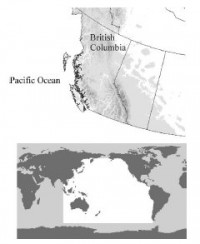
British Columbia has a long Pacific Ocean coastline; given that theremay be teleconnections between the province’s forest fires and climate variability over the ocean, significant correlations may exist between forest fires and the sea surface temperature of the Pacific Ocean. Fire occurrences and areas burned through lightning-caused and human-caused fires were analyzed against individual 1 ×1 degree grid cells of anomalies in the sea surface temperature to determine correlations for the period 1950-2006. Significant correlations (p < 0.05) for vast areas of the ocean were found between occurrences of lightning-caused fires and sea surface temperature anomalies for time lags of 1 and 2 years, whereas significant correlations between occurrences of human-caused fires and sea surface temperature anomalies occurred extensively for many time lags. To support the results of this approach, correlations between fire data and the Nino 3.4, Pacific Decadal Oscillation, and Arctic Oscillation indices were tested for the same period.
Significant correlations were found between fire occurrences and these indices at certain time lags. Overall, fire occurrence appeared to be more extensively correlated with sea surface temperature anomalies than was area burned. These results support the hypothesis that teleconnections exist between fire activity in British Columbia and sea surface temperatures in the Pacific Ocean, and the correlations suggest that linear regression models or other regression techniques may be appropriate for predicting fire severity from the sea surface temperatures of one or more previous years.
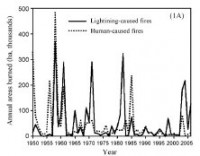
The advantages of our model are its simplicity and its ability to show the spatial correlation pattern in the Pacific. The purpose of our modeling exercise is to find if significant correlation exists between the Pacific SST and fires in British Columbia, and such information may provide information for developing regression models to predict current and future fire activity from previous years’ SSTs. Test results indicate that the model is suitable for this purpose. However, as the correlation is calculated cell by cell independently, the spatial relationships among the SST cells are not fully utilized. Although the model of Ni et al. (2006) involves climate variability and wildfire, the model they used is a pre-developed model of simulating ocean-atmospheric circulation, and it belongs to the simulation approach (Loehle and LeBlanc, 1996).
Although teleconnections exist between Pacific SST and BC fires, it should be pointed out that it is beyond the scope of this study to discuss the potential physical linkages between Pacific SST variability, atmospheric circulation, and forest fire activity in BC. Correlation analyses as conducted expose certain connections between SST and BC fires; however, finding the mechanisms that underlie the connections will require more effort in the future. For example, as the lightning-caused fire occurrence are directly related to the weather conditions in BC, futurework could be focused on the mechanism between the Pacific SST variability and the long-term changes of BC’s climate and weather.
See PDF of paper in press here.
Icecap Note: More proof that natural factors like the PDO controls the climate in western North America. The extremes in this region have been too quickly attributed to greenhouse warming. This study is timely given the recent extreme heat event in BC and the Pacific Northwest this week with forest fires associated with a strong positive PNA (Pacific North American) event related to the onset of a El Nino with warming in Nino34.
Thanks to Imelda and Edwin and Meteorologist Tim Kelley for photos from a flyover of northern end of Hudson’s Bay received last week. The photos were taken from northern Hudson Bay.
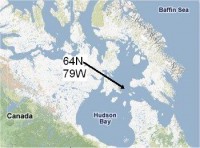
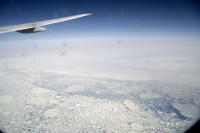
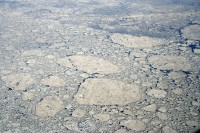
The ice has been diminishing since the mid 1990s with the warm Atlantic AMO. The AMO turned cooler in 2008-09 resulting in some recovery.
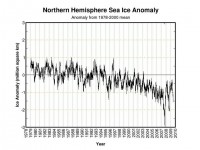
The ice is always on the move and is affected by both ocean temperatures from water entering the arctic from the Atlantic and Pacific and the low level flow pattern. The high latitude blocking over the arctic with low pressure over Siberia as we have seen this summer leads to clockwise flow that helps move ice out of the arctic into the Atlantic. See July surface pressure below (enlarged here).
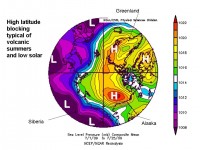
See more with larger images here. See also Tim’s post on the recent storm behaving semi tropical system of July 23-24, 2009 here.
See Climate Depot’s Arctic Fact Sheet here.
See Jeff ID’s discussion of the current ice extent and some amazing animations of the arctic ice here.

Amount as of August 3, 2009 above. See latest here.
See enlarged short-term youtube video painstakingly created by Jeff here. Jeff has created a longer loop from 1979 available on his post.
By Alan Caruba
There’s an ancient Scandinavian legend that says, “A long time ago, the universe was made of ice. Then one day the ice began to melt and a mist rose into the sky. Out of the mist came a giant made of frost and the earth and the heavens were made from his body. This is how the world began and this is how the world will end, not by fire, but by ice. The seas will freeze and winters will never end.”

Thus begins “Not by Fire, but by Ice”, a book by my friend, Robert W. Felix, published initially in 2005. You can pick up a copy here. While you’re there, pick up “Magnetic Reversals and Evolutionary Leaps” as well. Taken together, both books explain why the Earth, now at the end of an interglacial cycle, is heading into its next ice age and why Darwin got it wrong with his theory of slow, evolutionary mutations accounting for various species being different from one another.
The Earth is some 4.5 billion years old. Homo sapiens, the human race as we know it, have been around for about 40,000 years. We date our modern ancestry back to the Cro-Magnon man who superseded the Neanderthals. The development of agriculture, growing food rather than hunting it, dates back some 7,000 years and civilization in the form of city-states and nations is relatively new; only about 5,000 years.
For all that time, tribes tried very hard to appease the gods of sun and rain to ensure a good harvest. They would sacrifice the spare virgin or offer the hearts of captives. There were elaborate dances and prayers created by the shamans and priests, but humans never quite got the knack of actually controlling the weather or climate because they can’t and never could.
That is until Greenus Homo Sapian came along. This creature who emerged out of the conservation movement hit its stride around the 1970s. Greenus is the Bigfoot of climate, the Satchquatch of weather. After devoting a decade in the 1970s to correctly predicting that a new ice age was on the way, Greenus, also known as Greens, discovered that they could scare a lot more people by claiming that the Earth was suddenly and dramatically warming.
It turned out to be a fabulous fund-raiser and allowed them to pursue an agenda intended to rid the Earth of as many nasty Homo sapiens as possible. This would be accomplished by getting all kinds of beneficial chemicals banned from use; pesticides, herbicides, anything made from plastic, as well as genetically modified crops that could feed the billions of Homo sapiens.
Mostly, though, the Greens’ enemy were “fossil” or “dirty” fuels that just happened to generate the energy required for all modern society everywhere; coal, oil and natural gas.
The instrument of this “global warming”, according to the Greens, was carbon dioxide, a gas that is vital to all life on Earth. Without carbon dioxide (CO2) not a single bit of vegetation would grow. Remember agriculture? No crops, no food. And, if CO2 was forcibly limited by crazy “Cap-and-Trade” schemes, the Greens could depress the economies of nations.
Carbon dioxide was especially abundant in the atmosphere during the Jurassic period and the vegetation was so thick that lizard-like creatures became giants called dinosaurs. They were the masters of the Earth until something happened and they disappeared. Did a giant meteor wipe them out or was it a cyclical magnetic reversal that corresponds time and again with species extinction and the sudden appearance of entirely new species?
The “global warming” myth originated in the United Nations, an organization seeking to be the single, unelected governing institution for the entire Earth. A conspiracy of alleged scientists was brought together as the Intergovernmental Panel on Climate Change in 1988. Ever since, we have been assailed with claims that “global warming” was such a threat to the Earth and mankind that radical changes were required to avoid it.
The Greens, however, are running smack into a brick wall called reality. All over the Earth, temperatures have been steadily falling. It is getting cooler and colder everywhere. In a recent, desperate effort, the Union of Concerned Scientists announced that “Global warming made it less cool.” That’s right. It’s getting cooler because it’s getting warmer. Newborn babes arrive fresh from the womb laughing at this absurdity. At sites like Iceagenow.com and over at the most excellent climatedepot anyone with access to the Internet can learn about how weather records are being broken daily around the Earth as it cools. In Al Gore’s hometown of Nashville, cold temperatures broke a record set in 1877 when Rutherford B. Hayes was president. Chicago, Cincinnati, Peoria, California, the Arctic - everywhere!
So, who are you going to believe? The UN’s Intergovernmental Panel on Climate Change? The Union of Concerned Scientists? The Sierra Club? Friends of the Earth? U.S. government agencies like NOAA? The National Geographic? Newsweek? Time? President Obama? His cabinet Secretaries? The endless succession of “czars” he keeps appointing? Congress? You better not believe Congress because they are getting ready to pass the “Cap-and-Trade” bill, incongruously named the American Clean Energy and Security Act. It will crush what’s left of the U.S. economy by imposing taxes on all energy use while dolling out billions to the least effective form of energy, wind and solar energy.
As America and the rest of the globe grow colder, do you really want to pay more for the energy to heat your home? All in the name of avoiding a “global warming” that is not happening? Read full post here.
By Steve McIntyre, Climate Audit
Note: In a prior post , CRU Refuses Data Once Again, Steve noted: Let me review the request situation for readers. There are two institutions involved in the present round of FOI/EIR requests: CRU and the Met Office. Phil Jones of CRU collects station data and sends his “value added” version to the Met Office, who publish the HadCRU combined land-and-ocean index and also distribute the CRUTEM series online.
I requested a copy of the “value added” version from the Met Office (marion.archer at metoffice.uk.gov) which has been refused for excuses provided in my last post. On June 25, 2009, learning that Phil Jones had sent a copy of the station data to Peter Webster of Georgia Tech, I sent a new FOI request to CRU ( david.palmer at uea.ac.uk) requesting the data in the form sent to Peter Webster. This too was refused today.
A Mole
Posted July 25, 2009
OK, folks, guess what. I’m now in possession of a CRU version giving data for every station in their station list . In their refusal letter, the Met Office described adverse consequences of disclosing CRU station data, an event that apparently would let loose the Four Horsemen of the Apocalypse.
The Met Office stated: Some of the information was provided to Professor Jones on the strict understanding by the data providers that this station data must not be publicly released. If any of this information were released, scientists could be reluctant to share information and participate in scientific projects with the public sector organisations based in the UK in future. It would also damage the trust that scientists have in those scientists who happen to be employed in the public sector and could show the Met Office ignored the confidentiality in which the data information was provided.
They continued: “...the effective conduct of international relations depends upon maintaining trust and confidence between states and international organisations. This relationship of trust allows for the free and frank exchange of information on the understanding that it will be treated in confidence. If the United Kingdom does not respect such confidences, its ability to protect and promote United Kingdom interests through international relations may be hampered.
Competitors/Collaborators could be damaged by the release of information which was given to us in confidence and this will detrimentally affect the ability of the Met Office (UK) to co-operate with meteorological organisations and governments of other countries. This could also provoke a negative reaction from scientist globally if their information which they have requested remains private is disclosed.
And that’s not all. There’s more:
“...to release it without authority would seriously affect the relationship between the United Kingdom and other Countries and Institutions.”
CRU was a less dramatic but still very clear about the consequences: “...we feel that there is a strong public interest in upholding contract terms governing the use of received information. To not do so would be to potentially risk the loss of access to such data in future.
It’s hard to imagine that my being in possession of CRU station data would “damage the trust that scientists have in those scientists who happen to be employed in the public sector”, interfere with the “effective conduct of international relations”, “hamper the ability to protect and promote United Kingdom interests through international relations” and “seriously affect the relationship between the United Kingdom and other Countries and Institutions.”
But that’s what the Met Office says.
Given such dramatic adverse consequences, I wonder what they’ll do. Will they investigate? I wonder what the form of investigation will be. Will they do it Jack Nicholson-style?
I’ll keep my eye out for secret agents from MI-5. The data’s in a safe place, but I doubt that I would bear up well under waterboarding. And by the way, just because I’ve got a version of the data doesn’t mean that I’m going to give up trying to get the data through FOI. Quite the opposite.
See the continuing saga in posts on Climate Audit.
Icecap note: In a prior futile effort to access the data and algorithms/adjustments made, Phil Jones responded something like “why should I give you my data, you will only find something wrong with it.”
By Doug Wyatt, Geologist and Geophysicist
Hubris in global climate science scares me. As a scientist, I often carry a British coin that bears Isaac Newton’s statement “standing on the shoulders of giants” as a reminder of humility. I try to remember that most of what I know and understand comes from the work of others before me and a larger reservoir of existing knowledge. Considering this, and hoping knowledge leads to wisdom, it becomes very important to seek wisdom in the climate-change discussion.
Consider geology. From the recent G8 discussions, it is apparent that we are intent, as humans, to mitigate global climate change. During a recent climate-change forum, I heard a distinguished International Panel on Climate Change scientist state that “113 distinguished scientists” agreed that the earth is warming. This statement was made, rather emphatically, to a room filled with hundreds of geologists who did not react at all. The fact is that geoscientists worldwide, and possibly many archaeologists, would agree.
The earth has been warming for the past 18,000 years, since the last ice age. Climate change since the last glacial maximum and the resulting Holocene (recent geologic period) warming and sea level rise is a fundamental fact in the earth sciences. Temperatures have varied, sea levels have risen and fallen and ice sheets grown and diminished many times in the past, with evidence readily apparent in nature. Data from ice core studies, sediment analyses, locations of ancient shorelines, submerged archaeological sites and even from the oral traditions of ancient peoples all verify the Holocene sea level rise plus many more in the deep past. Most if not all of our history begins after the last glacial maximum, and in fact, modern human civilization has developed in a geologic period of increasing global temperatures.
Enter hubris. Humans tend to judge everything by the now and in terms of our own lifetimes. Events in the time of our grandparents were long ago, and anything over a few hundred years is ancient. For the earth, these are short-term concepts. However, if science indicates we have been warming since ice last covered half of North America, then we are not dealing with short-term events.
We are experiencing global phenomena that occur on geological and astronomical time scales. The earth’s climate is variable, on measured and predictable time-scales, fully supported by an amazing array of data from numerous scientific disciplines. If we have such absolute proof of global climate variability in the recent and geological past, should we not be very careful in our approach to the present? Consider sea level rise alone.
In the Carolinas, there are ancient shorelines many miles inland. Globally, there are numerous archaeological sites submerged by rising seas. What else has changed? The addition of 6 billion people, ever growing, and most gauging the universe against the metric of their own existence. It is only natural, I guess.
Use wisdom. Statisticians often say, “correlation does not imply causation,” but as our population grows there will be environmental effects - not just because of any unique changes in the dynamic earth system caused by man but because we increasingly notice, or measure, natural changes by our human reference frame. It only makes sense because any change will progressively affect more and more people. This is true for the carbon dioxide debate. Carbon dioxide has been increasing naturally due to global warming. It is an equilibrium response. If we are adding significantly more carbon dioxide to the process, the earth will respond according to pre-existing natural cycles but maybe not according to our human metrics. If we are not adding significantly more carbon dioxide to the process, then pre-existing global processes will still continue. Wisdom comes in knowing the difference and that maybe our knowledge is not sufficient.
We need to better understand causation and the global systems and then task our uniquely human ability to research, engineer, utilize and benefit from nature in efficient and comprehensive methods.
Avoid hubris. The global climate will change. It has in the past and will continue in the future with or without us. It is a part of our dynamic planet that makes life possible. We learn, understand, adapt and utilize.
Before we assume that not only are we the cause of global warming but also the cure, let us make sure the science is comprehensive and that we have the knowledge and wisdom necessary. As the writer of Ecclesiastes aptly states, “Generations come and generations go, but the earth remains forever”. Read more here.
By Alan Jones, LiveNews
Malcolm Turnbull today, in the headlines for the wrong reason, does not seem to know which way to jump on climate change. He’s now floated a new strategy but the suggestions are that he doesn’t have shadow Cabinet support for it. Well, may I direct his attention to a piece in the Wall Street Journal at the end of last month.
Rick Shaffer has a television job in America called the Money Show. He’s an attorney, a graduate of Boston College and Northeastern University School of Law. And he referred his viewers/listeners to a column that recently appeared in the Wall Street Journal pointing out and explaining the growing scepticism amongst scientists and politicians around the world, including the United States, over the accuracy of the so-called unarguable fact that global warming is occurring, is caused by mankind and can be cured by mankind.
And Shaffer asked, why is it important for this to be discussed on the Money Show. And he made the point, that to force industries and business to significantly raise their costs to meet environmental goals based on questionable science makes very little sense and will only cause more harm and greater difficulty to the economy. And as he wrote: “To do so during America’s worst recession or economic downturn in over 70 years is at best complete foolishness.”
Now the Wall Street Journal piece of June 26 this year raised the name of Australian Senator Steve Fielding. And it said Steve Fielding recently asked the Obama administration to reassure him on the science of man-made global warming. When the administration proved unhelpful, Mr Fielding decided to vote against climate change legislation. The Wall Street Journal said: “If you haven’t heard of this politician it’s because he’s a member of the Australian Senate. As the US House of Representatives prepares to pass a climate change bill, the Australian Parliament is preparing to kill its own country’s carbon emissions scheme.
Well, are we? The Wall Street Journal said “Among the many reasons President Barack Obama and the Democratic majority are so intent on quickly jamming a cap and trade system through Congress is because the global warming tide is shifting. Again in the Wall Street Journal: “In April the Polish Academy of Sciences published a document challenging man-made global warming. The Journal said: “In the Czech Republic, where President Vaclav Klaus remains a leading sceptic, today only 11 per cent of the population believes humans play a role.
“In France, Nicolas Sarkozy wants to tap Claude Allegre to lead the country’s new ministry of industry and innovation. “Twenty years ago Mr Allegre was among the first to trill about man-made global warming, but the geochemist has since recanted.
“New Zealand last year,” says the Wall Street Journal, “elected a new Government which immediately suspended the country’s weeks old cap and trade programme."The Journal said: “The number of sceptics, far from shrinking, is swelling. Oklahoma Senator Jim Inhofe now counts more than 700 scientists who disagree with the United Nations, 13 times the number who authored the UN’s 2007 Climate Summary for Policy Makers.”
Shaffer writes: “Joanne Simpson, the world’s first woman to receive a PhD in meteorology, expressed relief upon her retirement last year that she was finally free to speak frankly of her non-belief. Dr Kiminori Itoh, a Japanese environmental physical chemist who contributed to a UN climate report, dubs man-made warming the worst scientific scandal in history.
Norway’s Ivar Giaever, Nobel prize winner for physics, decries it as the new religion. Shaffer writes: “A group of 54 noted physicists, led by Princeton’s Will Happer, is demanding the American Physical Society revise its position that the science is settled.” Says the Wall Street Journal: “The collapse of the consensus has been driven by reality. The inconvenient truth is that the earth’s temperatures have flatlined since 2001, despite growing concentrations of CO2.
“Peer-reviewed research has debunked doomsday scenarios about the polar icecaps, hurricanes, malaria, extinctions, rising oceans. “A global financial crisis has politicians taking a harder look at the science that would require them to hamstring their economies to rein in carbon.”
The Journal describes Senator Stephen Fielding as “so alarmed by the renewed science debate that he made a fact-finding trip to the US, attending the Heartland Institute’s annual conference for climate sceptics. “He also visited with Joseph Aldy, Mr Obama’s special assistant on energy and the environment, where he challenged the Obama team to address his doubts. They apparently didn’t.” Well, the real question mark in all of this is when is Mr Rudd going to admit, not that he’s wrong, but that he just may not be right. Malcolm Turnbull, you are worshipping at the wrong altar.
See story and video here.
By Senator James Inhofe
As a former mayor, I have a unique appreciation for this hearing. Whether a mayor, governor, or town councilman, whether Republican, Democrat, or Independent, local officials have a keen, first-hand understanding of their states and communities, and the issues that affect them. I look forward to your testimony today.
Because states differ in many respects, you will hear differing perspectives on cap-and-trade and green jobs. As I’ve stated before, cap-and-trade benefits the coasts at the expense of the heartland. Cap-and-trade divides rather than unites America behind a sensible, workable energy policy. This fact is clear in the testimony of Arkansas State Rep. John Lowery, who is a Democrat.
When it comes to Waxman-Markey, Rep. Lowery is clear: “Unfortunately,” he said, “this bill will devastate my region. It will kill jobs, harm our school system, throw back our economic progress gained the last few years, and imposes a disproportionate burden on Arkansans.”
Rep. Lowery also speaks eloquently about a “way of life” that would perish under cap-and-trade. He is referring to life in Arkansas and rural America. Cap-trade supporters see rural America as wasteful and environmentally backward. They see those in rural America as mere contingencies in the battle to save the planet. But these are real people with real jobs and real families. And for them, cap-and-trade will spell economic disaster.
The debate over cap-and-trade does is not partisan; it’s regional. And I can tell you, when it comes to energy policy, Democrats in the Midwest and the South think differently than Speaker Pelosi and Henry Waxman. On the one hand, the policy of the coasts is to ration energy and make it more expensive through regulations and mandates.
On the other hand, the policy of the heartland is to increase domestic energy supplies - including wind, solar, geothermal, as well as oil, gas, nuclear, and coal - to make energy cleaner, more affordable, more abundant, and more reliable. In our part of the world, we invite new energy development, whatever its form, because we know it creates jobs and expands our economies.
This is the policy of North Dakota, as Gov. Hoeven will describe in his testimony. North Dakota is finding success in deploying new technologies to burn coal more cleanly and to drill and extract oil and gas with a minimal environmental footprint. North Dakota isn’t taxing, or creating new layers of bureaucracy; it’s developing domestic resources and creating jobs and energy security. Thus it’s no surprise that North Dakota currently has a budget surplus.
Those in the heartland are rightly skeptical about promises of green jobs and a new economy. They ask a simple question: what does this mean for my community and my state? There’s nothing inherently wrong with “green jobs,” so long as they don’t replace existing jobs. But this is exactly what Speaker Pelosi and Henry Waxman are talking about. They, along with President Obama, want to emulate the Spanish model, which has been a failure.
So let’s look at Spain for a minute. Now it’s true that new wind farms and other forms of alternative energy have created jobs in Spain. Yet a recent study by Dr. Gabriel Calzada of the Universidad Rey Juan Carlos calculates that the programs creating those jobs destroyed nearly 110,500 jobs elsewhere in the economy - or 2.2 jobs destroyed for every “green job” created.
The study also concludes that these jobs are temporary - in fact, only one out of ten jobs has been created for actual operation and maintenance of new plants. And the authors conclude that the costs of creating green jobs “do not appear to be unique to Spain’s approach but instead are largely inherent in schemes to promote renewable energy sources.”
This math just doesn’t add up. The Waxman-Markey bill will destroy far more jobs than it will create. In fact, the authors of the bill assume that it will kill jobs. When I read through it, I found an unemployment insurance program designed specifically for workers who lose their jobs because of Waxman-Markey. It also includes federal assistance for job relocation and job searching.
Rural America wants a different policy, one that recognizes the need to produce all forms of energy, ranging from wind to clean coal. No policy that includes 1,400 pages of mandates, taxes, and regulations will produce jobs or energy. And any such policy will threaten the rural way of life. We must defeat this bill or anything like it and pass a commonsense energy policy for America. See release here.
See the update: “Democrats Take Aim at Cap-and-Trade: “Ticking Time Bomb” - “Blood in the Water” - “Wrong Approach” here.
By John Christy, William B. Norris, and Richard T. McNider, Journal of Climate
The observation that the trends of TMax and TMin are different in many locations around the world has been documented in several sources (e.g., Easterling et al. 1997) though when globally averaged, the difference seems to have been decreasing in the most recent two decades (Vose et al. 2005), unlike our results for East Africa. The implication of our reconstruction for East Africa, north Alabama (Christy 2002), and central California (Christy et al. 2006) support the lack of positive trends in TMax, and thus the possibility that these truly indicate the nature of changes in the deep troposphere.
The fact that the difference in trends in TMax and TMin continues, and in fact accelerates, in the period of 1979–2004 in East Africa may be important in interpreting the results of Vose et al. (2005). While it is possible that East Africa difference trends are indeed different than that of the globe as provided by Vose et al. (2005), there is concern that the reduced number of stations in the 1979-2004 GHCN dataset may not be sampling many of the areas of the globe that are behaving like East Africa. Thus, it is important that the GHCN dataset be expanded to include more stations distributed around the globe.
The noticeable difference in trends of TMax and TMin implies that daytime and nighttime temperatures are responding differently to environmental factors.
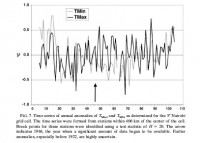
Larger image here.
Changes in the surface characteristics and the boundary layer atmospheric constituents may be responsible for the relatively recent and rapid rise in TMin. There appears to be little change in East Africa’s TMax, and if TMax is a suitable proxy for climate changes affecting the deep atmosphere, there has been little impact in the past half-century.
The investigation of the surface temperature record as an indicator of human-induced climate change involves understanding the complex behavior of boundary layer processes (where surface temperatures are actually measured) and how temperatures within it are affected by the numerous changes that occur. This is an area of research open for considerable inquiry because it raises new questions concerning the types of data indices now used to detect climate change. At the least, the time series of both TMax and TMin should become separate variables to be studied for long-term changes.




